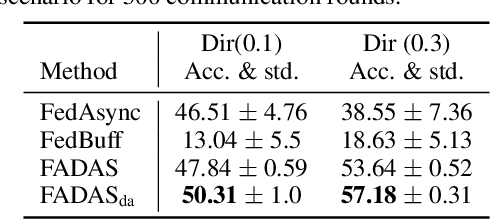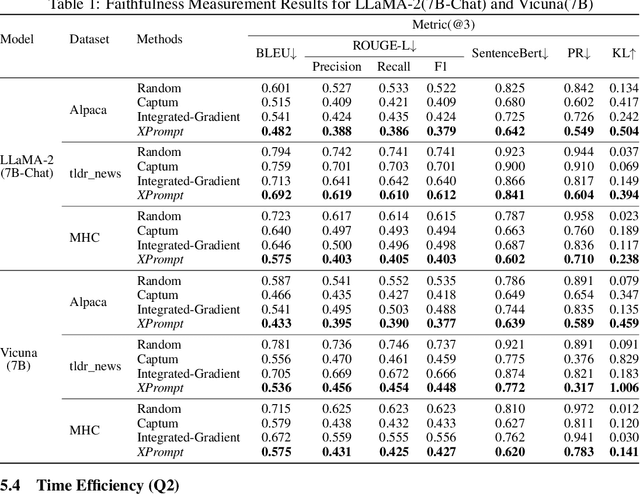Yujia Wang
AltLoRA: Towards Better Gradient Approximation in Low-Rank Adaptation with Alternating Projections
May 18, 2025Abstract:Low-Rank Adaptation (LoRA) has emerged as an effective technique for reducing memory overhead in fine-tuning large language models. However, it often suffers from sub-optimal performance compared with full fine-tuning since the update is constrained in the low-rank space. Recent variants such as LoRA-Pro attempt to mitigate this by adjusting the gradients of the low-rank matrices to approximate the full gradient. However, LoRA-Pro's solution is not unique, and different solutions can lead to significantly varying performance in ablation studies. Besides, to incorporate momentum or adaptive optimization design, approaches like LoRA-Pro must first compute the equivalent gradient, causing a higher memory cost close to full fine-tuning. A key challenge remains in integrating momentum properly into the low-rank space with lower memory cost. In this work, we propose AltLoRA, an alternating projection method that avoids the difficulties in gradient approximation brought by the joint update design, meanwhile integrating momentum without higher memory complexity. Our theoretical analysis provides convergence guarantees and further shows that AltLoRA enables stable feature learning and robustness to transformation invariance. Extensive experiments across multiple tasks demonstrate that AltLoRA outperforms LoRA and its variants, narrowing the gap toward full fine-tuning while preserving superior memory efficiency.
AutoGLM: Autonomous Foundation Agents for GUIs
Oct 28, 2024



Abstract:We present AutoGLM, a new series in the ChatGLM family, designed to serve as foundation agents for autonomous control of digital devices through Graphical User Interfaces (GUIs). While foundation models excel at acquiring human knowledge, they often struggle with decision-making in dynamic real-world environments, limiting their progress toward artificial general intelligence. This limitation underscores the importance of developing foundation agents capable of learning through autonomous environmental interactions by reinforcing existing models. Focusing on Web Browser and Phone as representative GUI scenarios, we have developed AutoGLM as a practical foundation agent system for real-world GUI interactions. Our approach integrates a comprehensive suite of techniques and infrastructures to create deployable agent systems suitable for user delivery. Through this development, we have derived two key insights: First, the design of an appropriate "intermediate interface" for GUI control is crucial, enabling the separation of planning and grounding behaviors, which require distinct optimization for flexibility and accuracy respectively. Second, we have developed a novel progressive training framework that enables self-evolving online curriculum reinforcement learning for AutoGLM. Our evaluations demonstrate AutoGLM's effectiveness across multiple domains. For web browsing, AutoGLM achieves a 55.2% success rate on VAB-WebArena-Lite (improving to 59.1% with a second attempt) and 96.2% on OpenTable evaluation tasks. In Android device control, AutoGLM attains a 36.2% success rate on AndroidLab (VAB-Mobile) and 89.7% on common tasks in popular Chinese APPs.
FADAS: Towards Federated Adaptive Asynchronous Optimization
Jul 25, 2024



Abstract:Federated learning (FL) has emerged as a widely adopted training paradigm for privacy-preserving machine learning. While the SGD-based FL algorithms have demonstrated considerable success in the past, there is a growing trend towards adopting adaptive federated optimization methods, particularly for training large-scale models. However, the conventional synchronous aggregation design poses a significant challenge to the practical deployment of those adaptive federated optimization methods, particularly in the presence of straggler clients. To fill this research gap, this paper introduces federated adaptive asynchronous optimization, named FADAS, a novel method that incorporates asynchronous updates into adaptive federated optimization with provable guarantees. To further enhance the efficiency and resilience of our proposed method in scenarios with significant asynchronous delays, we also extend FADAS with a delay-adaptive learning adjustment strategy. We rigorously establish the convergence rate of the proposed algorithms and empirical results demonstrate the superior performance of FADAS over other asynchronous FL baselines.
XPrompt:Explaining Large Language Model's Generation via Joint Prompt Attribution
May 30, 2024



Abstract:Large Language Models (LLMs) have demonstrated impressive performances in complex text generation tasks. However, the contribution of the input prompt to the generated content still remains obscure to humans, underscoring the necessity of elucidating and explaining the causality between input and output pairs. Existing works for providing prompt-specific explanation often confine model output to be classification or next-word prediction. Few initial attempts aiming to explain the entire language generation often treat input prompt texts independently, ignoring their combinatorial effects on the follow-up generation. In this study, we introduce a counterfactual explanation framework based on joint prompt attribution, XPrompt, which aims to explain how a few prompt texts collaboratively influences the LLM's complete generation. Particularly, we formulate the task of prompt attribution for generation interpretation as a combinatorial optimization problem, and introduce a probabilistic algorithm to search for the casual input combination in the discrete space. We define and utilize multiple metrics to evaluate the produced explanations, demonstrating both faithfulness and efficiency of our framework.
Can LLMs Learn from Previous Mistakes? Investigating LLMs' Errors to Boost for Reasoning
Mar 29, 2024



Abstract:Recent works have shown the benefits to LLMs from fine-tuning golden-standard Chain-of-Thought (CoT) rationales or using them as correct examples in few-shot prompting. While humans can indeed imitate correct examples, learning from our mistakes is another vital aspect of human cognition. Hence, a question naturally arises: \textit{can LLMs learn and benefit from their mistakes, especially for their reasoning? } This study investigates this problem from both the prompting and model-tuning perspectives. We begin by introducing \textsc{CoTErrorSet}, a new benchmark with 609,432 questions, each designed with both correct and error references, and demonstrating the types and reasons for making such mistakes. To explore the effectiveness of those mistakes, we design two methods: (1) \textbf{Self-rethinking} prompting guides LLMs to rethink whether they have made similar previous mistakes; and (2) \textbf{Mistake tuning} involves finetuning models in both correct and incorrect reasoning domains, rather than only tuning models to learn ground truth in traditional methodology. We conduct a series of experiments to prove LLMs can obtain benefits from mistakes in both directions. Our two methods offer potentially cost-effective strategies by leveraging errors to enhance reasoning capabilities, which costs significantly less than creating meticulously hand-crafted golden references. We ultimately make a thorough analysis of the reasons behind LLMs' errors, which provides directions that future research needs to overcome. \textsc{CoTErrorSet} will be published soon on \texttt{Anonymity Link}.
Federated Learning with Projected Trajectory Regularization
Dec 22, 2023Abstract:Federated learning enables joint training of machine learning models from distributed clients without sharing their local data. One key challenge in federated learning is to handle non-identically distributed data across the clients, which leads to deteriorated model training performances. Prior works in this line of research mainly focus on utilizing last-step global model parameters/gradients or the linear combinations of the past model parameters/gradients, which do not fully exploit the potential of global information from the model training trajectory. In this paper, we propose a novel federated learning framework with projected trajectory regularization (FedPTR) for tackling the data heterogeneity issue, which proposes a unique way to better extract the essential global information from the model training trajectory. Specifically, FedPTR allows local clients or the server to optimize an auxiliary (synthetic) dataset that mimics the learning dynamics of the recent model update and utilizes it to project the next-step model trajectory for local training regularization. We conduct rigorous theoretical analysis for our proposed framework under nonconvex stochastic settings to verify its fast convergence under heterogeneous data distributions. Experiments on various benchmark datasets and non-i.i.d. settings validate the effectiveness of our proposed framework.
ToxicChat: Unveiling Hidden Challenges of Toxicity Detection in Real-World User-AI Conversation
Oct 26, 2023Abstract:Despite remarkable advances that large language models have achieved in chatbots, maintaining a non-toxic user-AI interactive environment has become increasingly critical nowadays. However, previous efforts in toxicity detection have been mostly based on benchmarks derived from social media content, leaving the unique challenges inherent to real-world user-AI interactions insufficiently explored. In this work, we introduce ToxicChat, a novel benchmark based on real user queries from an open-source chatbot. This benchmark contains the rich, nuanced phenomena that can be tricky for current toxicity detection models to identify, revealing a significant domain difference compared to social media content. Our systematic evaluation of models trained on existing toxicity datasets has shown their shortcomings when applied to this unique domain of ToxicChat. Our work illuminates the potentially overlooked challenges of toxicity detection in real-world user-AI conversations. In the future, ToxicChat can be a valuable resource to drive further advancements toward building a safe and healthy environment for user-AI interactions.
Communication-Efficient Adaptive Federated Learning
May 05, 2022



Abstract:Federated learning is a machine learning training paradigm that enables clients to jointly train models without sharing their own localized data. However, the implementation of federated learning in practice still faces numerous challenges, such as the large communication overhead due to the repetitive server-client synchronization and the lack of adaptivity by SGD-based model updates. Despite that various methods have been proposed for reducing the communication cost by gradient compression or quantization, and the federated versions of adaptive optimizers such as FedAdam are proposed to add more adaptivity, the current federated learning framework still cannot solve the aforementioned challenges all at once. In this paper, we propose a novel communication-efficient adaptive federated learning method (FedCAMS) with theoretical convergence guarantees. We show that in the nonconvex stochastic optimization setting, our proposed FedCAMS achieves the same convergence rate of $O(\frac{1}{\sqrt{TKm}})$ as its non-compressed counterparts. Extensive experiments on various benchmarks verify our theoretical analysis.
Communication-Compressed Adaptive Gradient Method for Distributed Nonconvex Optimization
Nov 01, 2021



Abstract:Due to the explosion in the size of the training datasets, distributed learning has received growing interest in recent years. One of the major bottlenecks is the large communication cost between the central server and the local workers. While error feedback compression has been proven to be successful in reducing communication costs with stochastic gradient descent (SGD), there are much fewer attempts in building communication-efficient adaptive gradient methods with provable guarantees, which are widely used in training large-scale machine learning models. In this paper, we propose a new communication-compressed AMSGrad for distributed nonconvex optimization problem, which is provably efficient. Our proposed distributed learning framework features an effective gradient compression strategy and a worker-side model update design. We prove that the proposed communication-efficient distributed adaptive gradient method converges to the first-order stationary point with the same iteration complexity as uncompressed vanilla AMSGrad in the stochastic nonconvex optimization setting. Experiments on various benchmarks back up our theory.
K-PLUG: Knowledge-injected Pre-trained Language Model for Natural Language Understanding and Generation in E-Commerce
Apr 14, 2021



Abstract:Existing pre-trained language models (PLMs) have demonstrated the effectiveness of self-supervised learning for a broad range of natural language processing (NLP) tasks. However, most of them are not explicitly aware of domain-specific knowledge, which is essential for downstream tasks in many domains, such as tasks in e-commerce scenarios. In this paper, we propose K-PLUG, a knowledge-injected pre-trained language model based on the encoder-decoder transformer that can be transferred to both natural language understanding and generation tasks. We verify our method in a diverse range of e-commerce scenarios that require domain-specific knowledge. Specifically, we propose five knowledge-aware self-supervised pre-training objectives to formulate the learning of domain-specific knowledge, including e-commerce domain-specific knowledge-bases, aspects of product entities, categories of product entities, and unique selling propositions of product entities. K-PLUG achieves new state-of-the-art results on a suite of domain-specific NLP tasks, including product knowledge base completion, abstractive product summarization, and multi-turn dialogue, significantly outperforms baselines across the board, which demonstrates that the proposed method effectively learns a diverse set of domain-specific knowledge for both language understanding and generation tasks.
 Add to Chrome
Add to Chrome Add to Firefox
Add to Firefox Add to Edge
Add to Edge